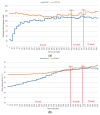Data Analytics of a Wearable Device for Heat Stroke Detection
- PMID: 30544887
- PMCID: PMC6308959
- DOI: 10.3390/s18124347
Data Analytics of a Wearable Device for Heat Stroke Detection
Abstract
When exercising in a high-temperature environment, heat stroke can cause great harm to the human body. However, runners may ignore important physiological warnings and are not usually aware that a heat stroke is occurring. To solve this problem, this study evaluates a runner's risk of heat stroke injury by using a wearable heat stroke detection device (WHDD), which we developed previously. Furthermore, some filtering algorithms are designed to correct the physiological parameters acquired by the WHDD. To verify the effectiveness of the WHDD and investigate the features of these physiological parameters, several people were chosen to wear the WHDD while conducting the exercise experiment. The experimental results show that the WHDD can identify high-risk trends for heat stroke successfully from runner feedback of the uncomfortable statute and can effectively predict the occurrence of a heat stroke, thus ensuring safety.
Keywords: exercise experiment; filtering algorithm; heat stroke; physiological parameters.
Conflict of interest statement
The authors declare no conflict of interest.
Figures



















References
-
- Global Climate Report—Annual 2017. [(accessed on 14 October 2018)]; Available online: https://www.ncdc.noaa.gov/sotc/global/201713.
-
- Guidelines for the Identification of Professional Diseases Caused by Heat Hazards. [(accessed on 30 October 2018)]; Available online: https://www.osha.gov.tw/1106/1176/1185/1190/1194/
-
- Gerrett N., Redortier B., Voelcker T., Havenith G. A comparison of galvanic skin conductance and skin wettedness as indicators of thermal discomfort during moderate and high metabolic rates. J. Therm. Boil. 2013;38:530–538. doi: 10.1016/j.jtherbio.2013.09.003. - DOI
-
- Mizota N., Lu H., Nakashima S., Zhang L., Serikawa S., Kitazono Y. Proposal of alert system for prevention of heat stroke; Proceedings of the 2012 IEEE/SICE International Symposium on System Integration (SII); Fukuoka, Japan. 16–18 December 2012; pp. 111–116. - DOI
-
- Casper R., Schlosser K., Pascucci R., Feldman J. Is it exertional heatstroke or something more? A case report. J. Emerg. Med. 2016;51:e1–e5. - PubMed
MeSH terms
Grants and funding
LinkOut - more resources
Full Text Sources
Other Literature Sources

